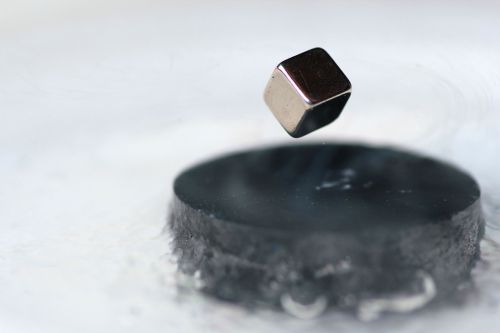Shedding light on cold Higgs

Superconductors are not only perfect conductors of electrical currents, but also display absolute diamagnetism which allows trapping of other magnets in their emergent magnetic field. Physicists of the University of Stuttgart now revealed another stunning property: A collective mode of superconducting electrons, the so-called Higgs mode, which is considered the solid-state analog to the only recently discovered Higgs particle.
When François Englert and Peter Higgs were awarded the 2013 Nobel Prize, a scientific breakthrough was honored that could hardly be more spectacular: born from pure calculations nearly half a century ago and theoretically predicted to exist, the Higgs particle is ultimately discovered by virtue of the largest experiment ever built, CERN´s Large Hadron Collider.
In the 1960s, particle physicists were puzzled by the mass of certain gauge bosons responsible for mediating the weak interaction. According to the state of scientific knowledge back at the time, all gauge bosons were believed to be massless just like the one carrying electromagnetic interactions, the photon.
The solution to this mass conundrum was almost concomitantly put in a nutshell by a number of groups and cast into an elegant theory commonly termed the Higgs mechanism. Beside its success in explaining the gauge bosons’ masses, the theory proposed the existence of a yet unknown heavy particle, the Higgs boson.
The fundamental concept utilized to solve the mass problem, that is symmetry-breaking, was not entirely new, though. Prior to its prominent role in particle physics, it was vastly used among theorists working on the similarly enigmatic problem of superconductivity, i.e. the non-dissipative electrical conduction at temperatures close to absolute zero.
Today we know that beyond first glance both fields, particle physics and superconductivity, are intimately entangled sharing a common ground that is not only of conceptual nature but also experimentally testable: The same excitation associated with the massive Higgs particle in a particle-physics framework should accordingly manifest in superconductors, the so-called Higgs mode. Unlike the single Higgs particle, the Higgs mode in superconductors is a collective mode of charged particles similar to, e.g., an acoustic wave travelling through liquids.
Similar to the Higgs particle at CERN, tracking down the Higgs mode had grown into a particularly demanding challenge. Being an excitation of comparably high energy it almost instantaneously decays into particle-hole pairs after its generation rendering the Higgs mode invisible in ordinary superconductors.
An international group of physicists led by Prof. Martin Dressel (University of Stuttgart) and Prof. Aviad Frydman (Tel Aviv University) recently found a suspiciously enhanced absorption of light in extremely thin films of strongly disordered superconductors which is shown to be in excellent agreement with the theoretically expected absorption caused by the Higgs mode, and is thus deemed the first direct proof of a stable Higgs mode in superconductors.
The obstacle of the ultra-short lifetime was circumvented by a trick inspired by relativistic theories: At very low temperatures, superconductors conduct electrical currents without any losses. However, being reduced to extremely thin films and subject to massive lattice distortion and defects, these materials may turn insulating once a critical degree of disorder, the quantum-critical point, is reached. Close to criticality, the so-far unstable Higgs mode is now well-defined, long-lived, and, moreover, directly detectable by optical measurements.
The German-Israeli collaboration now succeeded in tracing the Higgs mode´s gradual emergence with increasing disorder and found an astonishing agreement with theory. With this, on the one hand, the first direct experimental proof of a stable and well-defined Higgs mode in superconductors is accomplished, which in addition may inspire the search for the Higgs mode in similar disordered solid state systems, and, on the other hand, an intriguing concurrence between solid state and particle physics is unveiled.
More information:
Uwe Pracht, University of Stuttgart, 1. Physikalisches Institut, Tel.: +49(0)711/685-64941,
E-Mail: uwe.pracht@pi1.physik.uni-stuttgart.de
Andrea Mayer-Grenu, University of Stuttgart, Abt. Hochschulkommunikation, Tel. 0711/685-82176,
E-Mail: andrea.mayer-grenu (at) hkom.uni-stuttgart.de
Media Contact
More Information:
http://www.uni-stuttgart.de/All latest news from the category: Physics and Astronomy
This area deals with the fundamental laws and building blocks of nature and how they interact, the properties and the behavior of matter, and research into space and time and their structures.
innovations-report provides in-depth reports and articles on subjects such as astrophysics, laser technologies, nuclear, quantum, particle and solid-state physics, nanotechnologies, planetary research and findings (Mars, Venus) and developments related to the Hubble Telescope.
Newest articles

Silicon Carbide Innovation Alliance to drive industrial-scale semiconductor work
Known for its ability to withstand extreme environments and high voltages, silicon carbide (SiC) is a semiconducting material made up of silicon and carbon atoms arranged into crystals that is…

New SPECT/CT technique shows impressive biomarker identification
…offers increased access for prostate cancer patients. A novel SPECT/CT acquisition method can accurately detect radiopharmaceutical biodistribution in a convenient manner for prostate cancer patients, opening the door for more…

How 3D printers can give robots a soft touch
Soft skin coverings and touch sensors have emerged as a promising feature for robots that are both safer and more intuitive for human interaction, but they are expensive and difficult…





















